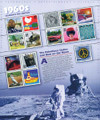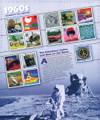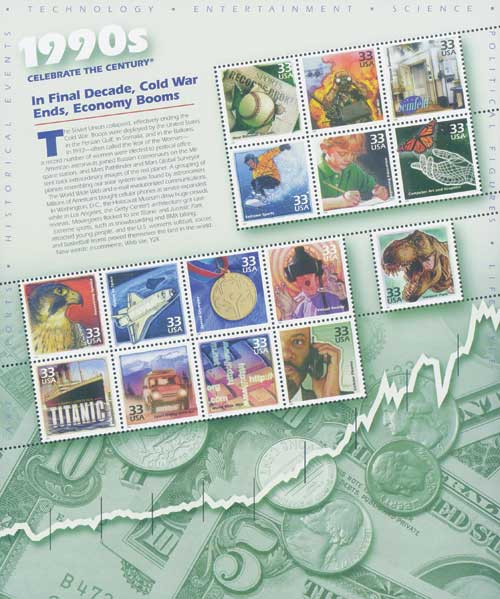
# 3188 - 1999 33c Celebrate the Century: 1960s
US #3188
1999 Celebrate the Century (1960s)
• The seventh sheet in the Celebrate the Century stamp series issued from 1998-2000
• Includes 15 stamps picturing important events from the 1960s
• Each stamp has text on the back detailing the event shown in the front design
Stamp Category: Commemorative
Series: Celebrate the Century
Value: 33¢ First Class Mail Rate
First Day of Issue: September 17, 1999
First Day City: Green Bay, Wisconsin
Quantity Issued: 120,000,000
Printed by: Ashton Potter (USA) Ltd.
Printing Method: Offset, Intaglio
Format: Panes of 15
Perforations: 11.5
Tagging: Block tagging
Why the stamps were issued: To commemorate important historical and cultural events from the 1960s that have a lasting legacy in the United States.
About the stamp designs: Picture artwork by Keith Birdsong of Muskogee, Oklahoma. The following topics were chosen for the 15 stamps on this sheet (and corresponding back markings of each):
“I Have a Dream” – On August 28, 1963, Dr. Martin Luther King, Jr. delivered his “I Have a Dream” speech to some 25,000 supporters in Washington DC. He eloquently described his faith in equality, justice, and freedom for all.
Woodstock – From August 15 to 18, 1969, approximately 500,000 people gathered for the Woodstock Music and Art Fair. This festival of peace and music celebrated the best of the ‘60s youth culture and came to symbolize a generation.
Man Walks on the Moon – President John F. Kennedy’s 1961 commitment to put a man on the moon was fulfilled July 20, 1969, when the lunar module Eagle landed on the surface of the moon, and astronauts Neil Armstrong and Buzz Aldrin walked on lunar soil.
Green Bay Packers – The Green Bay Packers were the preeminent professional football team of the ‘60s. They won five National Football League (NFL) championships between 1961 and 1967, as well as the first two Super Bowl games.
Star Trek – Created by Gene Roddenberry, the Star Trek TV series debuted in 1966. Captain James T. Kirk, Mr. Spock, and the other members of the Starship Enterprise ultimately earned cult status that mushroomed into international popularity.
The Peace Corps – Established by President Kennedy in 1961, the Peace Corps promotes world peace and cross-cultural understanding. Today, more than 7,000 volunteers in 80 countries help with education, health, agriculture, and the environment.
The Vietnam War – The Vietnam War was the longest military conflict in US history. The hostilities in Vietnam, Laos, and Cambodia claimed the lives of more than 58,000 Americans. Another 304,000 were wounded.
Ford Mustang – Introduced April 1964, the Mustang’s sporty styling, economic value, and long list of options appealed to men and women of all ages. Some 22,000 orders were taken the first day, and one million were produced in less than 24 months.
Barbie Doll – Introduced by Mattel in March 1959, the Barbie doll caused a sensation by providing young girls a teenage fashion doll with a large and stylish wardrobe. By 1963, sales had reached 5 million dolls and 25 million fashions.
The Integrated Circuit – Independently invented by Jack Kilby and Robert Noyce, the integrated circuit was first available commercially in 1961. It led to smaller, inexpensive, mass-produced electronic circuits, revolutionizing the computer industry.
Lasers – Lasers can provide light in a narrow beam of high intensity and pure color. They were first operated in 1960 and revolutionized technologies from communications to surgery and led to everyday items like CD players.
Super Bowl I – The first championship game between the American Football League and the National Football League was January 15, 1967. Later dubbed the Super Bowl, the NFL’s Green Bay Packers beat the Kansas City Chiefs.
Peace Symbol – The peace symbol’s design combines two flag signals, one for N and one for D, to represent Nuclear Disarmament. Adopted by anti-war protesters in the ‘60s, the symbol eventually became a universal sign of peace and love.
Roger Maris, 61 in ‘61 – In 1961, Roger Maris of the New York Yankees hit 61 home runs, setting a new Major League Baseball record, breaking the previous mark of 60 set in 1927.
The Beatles – The Beatles debuted on US TV February 9, 1964. Charming and exuberant, they captivated the nation. Their creativity helped revolutionize rock ‘n’ roll, moving it to a more artistically ambitious musical form.
First Day City: The First Day of Issue Ceremony was held at the Brown County Exposition Center in Green Bay, across the street from Lambeau Field, home of the Green Bay Packers football team.
About the Celebrate the Century series: The USPS launched the Celebrate the Century series in 1998 to mark the end of the 20th century and herald the arrival of the 21st. The series includes 10 sheets of 15 stamps (150 in total), with each honoring important moments from a different decade (1900s, 10s, 20s, 30s, 40s, 50s, 60s, 70s, 80s, and 90s). At the time of completion, it was the longest and most ambitious commemorative stamp series in US history.
US #3188
1999 Celebrate the Century (1960s)
• The seventh sheet in the Celebrate the Century stamp series issued from 1998-2000
• Includes 15 stamps picturing important events from the 1960s
• Each stamp has text on the back detailing the event shown in the front design
Stamp Category: Commemorative
Series: Celebrate the Century
Value: 33¢ First Class Mail Rate
First Day of Issue: September 17, 1999
First Day City: Green Bay, Wisconsin
Quantity Issued: 120,000,000
Printed by: Ashton Potter (USA) Ltd.
Printing Method: Offset, Intaglio
Format: Panes of 15
Perforations: 11.5
Tagging: Block tagging
Why the stamps were issued: To commemorate important historical and cultural events from the 1960s that have a lasting legacy in the United States.
About the stamp designs: Picture artwork by Keith Birdsong of Muskogee, Oklahoma. The following topics were chosen for the 15 stamps on this sheet (and corresponding back markings of each):
“I Have a Dream” – On August 28, 1963, Dr. Martin Luther King, Jr. delivered his “I Have a Dream” speech to some 25,000 supporters in Washington DC. He eloquently described his faith in equality, justice, and freedom for all.
Woodstock – From August 15 to 18, 1969, approximately 500,000 people gathered for the Woodstock Music and Art Fair. This festival of peace and music celebrated the best of the ‘60s youth culture and came to symbolize a generation.
Man Walks on the Moon – President John F. Kennedy’s 1961 commitment to put a man on the moon was fulfilled July 20, 1969, when the lunar module Eagle landed on the surface of the moon, and astronauts Neil Armstrong and Buzz Aldrin walked on lunar soil.
Green Bay Packers – The Green Bay Packers were the preeminent professional football team of the ‘60s. They won five National Football League (NFL) championships between 1961 and 1967, as well as the first two Super Bowl games.
Star Trek – Created by Gene Roddenberry, the Star Trek TV series debuted in 1966. Captain James T. Kirk, Mr. Spock, and the other members of the Starship Enterprise ultimately earned cult status that mushroomed into international popularity.
The Peace Corps – Established by President Kennedy in 1961, the Peace Corps promotes world peace and cross-cultural understanding. Today, more than 7,000 volunteers in 80 countries help with education, health, agriculture, and the environment.
The Vietnam War – The Vietnam War was the longest military conflict in US history. The hostilities in Vietnam, Laos, and Cambodia claimed the lives of more than 58,000 Americans. Another 304,000 were wounded.
Ford Mustang – Introduced April 1964, the Mustang’s sporty styling, economic value, and long list of options appealed to men and women of all ages. Some 22,000 orders were taken the first day, and one million were produced in less than 24 months.
Barbie Doll – Introduced by Mattel in March 1959, the Barbie doll caused a sensation by providing young girls a teenage fashion doll with a large and stylish wardrobe. By 1963, sales had reached 5 million dolls and 25 million fashions.
The Integrated Circuit – Independently invented by Jack Kilby and Robert Noyce, the integrated circuit was first available commercially in 1961. It led to smaller, inexpensive, mass-produced electronic circuits, revolutionizing the computer industry.
Lasers – Lasers can provide light in a narrow beam of high intensity and pure color. They were first operated in 1960 and revolutionized technologies from communications to surgery and led to everyday items like CD players.
Super Bowl I – The first championship game between the American Football League and the National Football League was January 15, 1967. Later dubbed the Super Bowl, the NFL’s Green Bay Packers beat the Kansas City Chiefs.
Peace Symbol – The peace symbol’s design combines two flag signals, one for N and one for D, to represent Nuclear Disarmament. Adopted by anti-war protesters in the ‘60s, the symbol eventually became a universal sign of peace and love.
Roger Maris, 61 in ‘61 – In 1961, Roger Maris of the New York Yankees hit 61 home runs, setting a new Major League Baseball record, breaking the previous mark of 60 set in 1927.
The Beatles – The Beatles debuted on US TV February 9, 1964. Charming and exuberant, they captivated the nation. Their creativity helped revolutionize rock ‘n’ roll, moving it to a more artistically ambitious musical form.
First Day City: The First Day of Issue Ceremony was held at the Brown County Exposition Center in Green Bay, across the street from Lambeau Field, home of the Green Bay Packers football team.
About the Celebrate the Century series: The USPS launched the Celebrate the Century series in 1998 to mark the end of the 20th century and herald the arrival of the 21st. The series includes 10 sheets of 15 stamps (150 in total), with each honoring important moments from a different decade (1900s, 10s, 20s, 30s, 40s, 50s, 60s, 70s, 80s, and 90s). At the time of completion, it was the longest and most ambitious commemorative stamp series in US history.
















